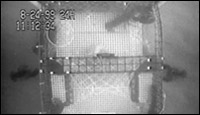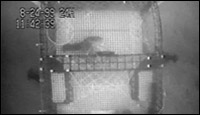|
Videos
Click to play |
|
 Video 1 |
|
 Video 2 |
|
 Video 3 |
LTV - Observations/Data
Based on our observations of approximately 24 videos obtained during the summers of 1998-2000, we have drawn a number of conclusions, a few of which are listed below. For more details about these studies see our first manuscript on the subject (Jury and Watson, 2001) in the Publication section of this website.
1. A large number of lobsters approach and enter traps, yet typically we only catch 1-3 per trap haul because the vast majority escape. We estimate that 10% of the lobsters that approach a trap enter, and of the ones that enter, only 6% are caught. Over 75% of the lobsters that escape the trap do so through the entrance. Video 1, on the right, shows a lobster escaping through the entrance to the kitchen.
2. Lobsters are very active around traps during the day, as well as the night. This confirms other field observations indicating that lobsters in their natural habitat are not as strickly nocturnal as previously thought.
3. Agonistic encounters around traps appear to limit entry and stimulate exits. Video 2 shows a large lobster chasing away smaller lobsters and then entering the trap. Small lobsters are very hesitant to enter, while larger lobsters tend to move right in like the one shown in this video.
4. Once in the trap, lobsters tend to "defend" the resource. Video 3 demonstrates this behavior. This also limits entry and it is probably one of the main behaviors that lead to trap "saturation".
